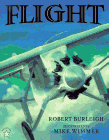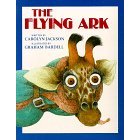Flight and Children's Literature
This article by Carol Otis Hurst first appeared in Teaching K-8 Magazine.

Let's leave the earth behind in a theme on Flight. That theme will give us a good hook for boys who tend to like non-fiction reading. There are lots of good books both fiction and non-fiction on airplanes. There will be ample opportunity for physical science activities in that direction. Famous people involved in flight will pull in the biographies. Mythology and fantasy of flight should bring in other interested readers.
The movie "Those Magnificent Men in Their Flying Machines" came out in 1965 and starred Terry Thomas, among others. Available on video, it's a funny movie about an air race and you may want to use the whole thing as a launch for the theme. Even if you don't want to give up that much time, the opening sequence shows men attempting to fly in an amazing array of contraptions. It leaves you laughing but also wondering why some of those airplanes flew, at least a bit, while others never left the ground. That's a step into physical science, of course.
Stay with physical science and suggest that the kids design paper planes that will fly, testing them out, making changes and coming up with their choice for a paper airplane contest. There are several books on the subject: and there's a computer program called "The Greatest Paper Airplanes" put out by KittyHawk Software. Design a contest that will show length and height of flight.
Chart the discoveries made during the paper airplane contest considering such factors as weight and quality of paper, overall size, wing spread and the like.
It's time to get out the books on flight both fiction and informational. Some suggestions:

Tanaka, Shelley. Illustrated by David Craig. Amelia Earhart: The Legend of the Lost Aviator. (2008, Abram. ISBN 9780810970953.) Order Info. Nonfiction. 48 pages. Gr 4-7.
This book covers her childhood and her flying career and her fight for women to be able to do anything a man can do. It is well written, full of great information even as it flows along quickly. The text is illustrated with period photographs and a few original illustrations. Source notes, a bibliography, recommended websites and an index are included.
Diane Siebert's Plane Song (HarperTrophy, 1995 ISBN 0064433676. Order Info.) is a delightful picture book for the very young about different kinds of planes and what they do.

Robert Burleigh's Flight: The Journey of Charles Lindbergh (Philomel, 1991 ISBN 0399222723. Order Info.) is beautifully told and beautiful to look at, as well.
Russell Freedman's The Wright Brothers: How They Invented the Airplane (Holiday House, 1991 ISBN 0823408752. Order Info.) is replete with photographs and intriguing information about the two men.
Carolyn Jackson's The Flying Ark (Fitzhenry and Whiteside, 1995 ISBN 0773757112. Order Info.) is about transporting zoo animals by plane.

Caroline Cooney's novel Flight #116 Is Down (San Val, 1999 ISBN 0785701826. Order Info.) concerns the downing of a 747 and it's effect on a variety of characters.
Look for photographs of early attempts at flight and compare some of the factors to those discovered in the paper airplane contest.
Make a bulletin board display of some of those photographs with the title question: WILL IT FLY? Suggest that students make educated guesses based on what they now about flight and tack yes or no tags to each picture. When everyone who's interested has made a guess, let individuals explain their reasons.
Contact airlines, the FAA and other agencies that deal with aviation safety. Get and compare statistics on the safety records of various airlines. Find ways to show this information in charts or graphs.
While we're looking at flight mathematically, put together some figures about costs. How much fuel does a commercial airliner consume during a flight. How far can a given plane go on that much fuel? How much does a commercial jet cost? How much does it make in a year? How many passengers can the biggest ones take?

It's time to get fantastical. Start with some books about unlikely fliers such as:
David Wiesner's Tuesday (Clarion, 1991 ISBN 0395551137. Order Info.) Read more.
Ursula LeGuin's Catwings (Scholastic, 1990 ISBN 0590428330. Order Info.)
Susan Jeschke's Perfect the Pig (Holt, 1980 ISBN 0805047042. Order Info.)
Arthur Dorros' Abuela (Dutton, 1991 ISBN 0525447504. Order Info.)
Brainstorm for ways in which frogs, pigs, people and cats in those books would have to change to be aerodynamically possible. Display the results of the brainstorming session.
Look at Byrd Baylor and Peter Parnall's Hawk, I Am Your Brother (Aladdin, 1986 ISBN 0689711026. Order Info.) to get some of the feelings of flight.
Step into mythology with two books by Jane Yolen. Wings (Harcourt, 1997 ISBN 0152015671. Order Info.) and Pegasus, the Flying Horse (Dutton, 1998 ISBN 0525652442. Order Info.). Wings is the story of Icarus, beautifully illustrated by Dennis Nolan. It can lead to more research on that story. Follow the threads (forgive the pun) and it will lead to the labyrinth, to the interaction of the gods and heroes or to the lesson it teaches about reach exceeding grasp.
Pegasus, the Flying Horse Is illustrated by Li Ming. Compare it to Marianna Mayer and Kinuko Craft's Pegasus (Morrow, 1998 ISBN 0688133835. Order Info.) for content as well as treatment.
Don't leave Pegasus without reaching for the wonderful wordless novel The Silver Pony by Lynd Ward (Houghton, 1973 ISBN 0395147530. Order Info.) which has strong parallels to both Pegasus and Icarus.
Get descriptive words and phrases from people who have flown. Put together a group poem on flight using some of them.
Get back to reality. Step up the investigation. Bring in people connected with the airplane industry. Visit an airfield. Assemble a display on the facts of the matter.
Investigate the effect on warfare of airplanes. How were they first used? What changed when airplanes became weapons of war?
Look to the debate on manned and unmanned space flight. Get a debate going on where the United States should be heading next.
We've only just begun this theme, of course. There's a long way to go. Good thing we've got fast planes to take us there. See you next month.
Related Areas of Carol Hurst's Children's Literature Site
- Fly Away Home by Eve Bunting. Featured Book with Related Activities, Books and Links.
- Tuesday by David Wiesner. Book Review.
- Subjects and Themes in Children's Literature.
Advertisement:
Advertisement:
Advertisement:

